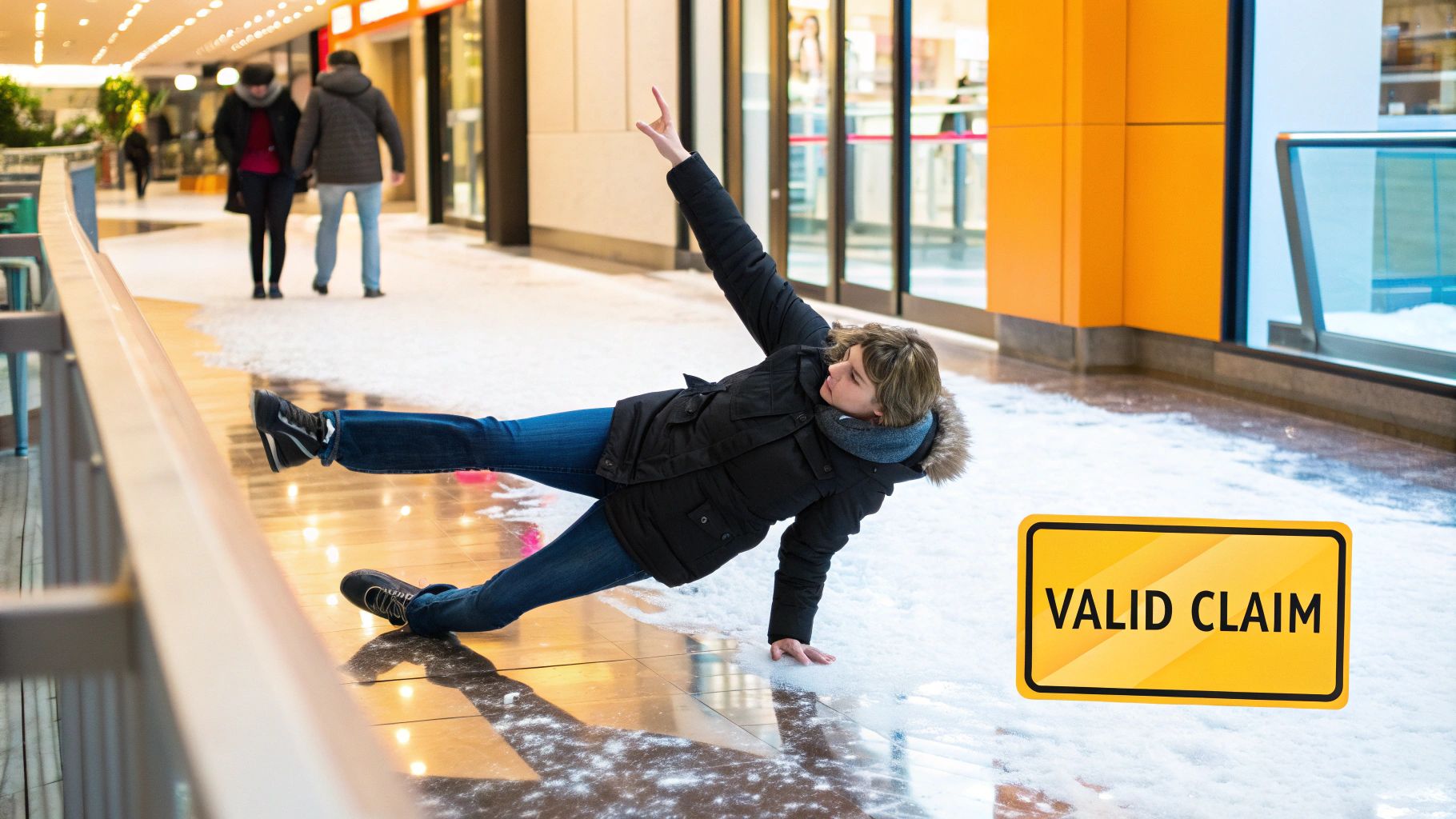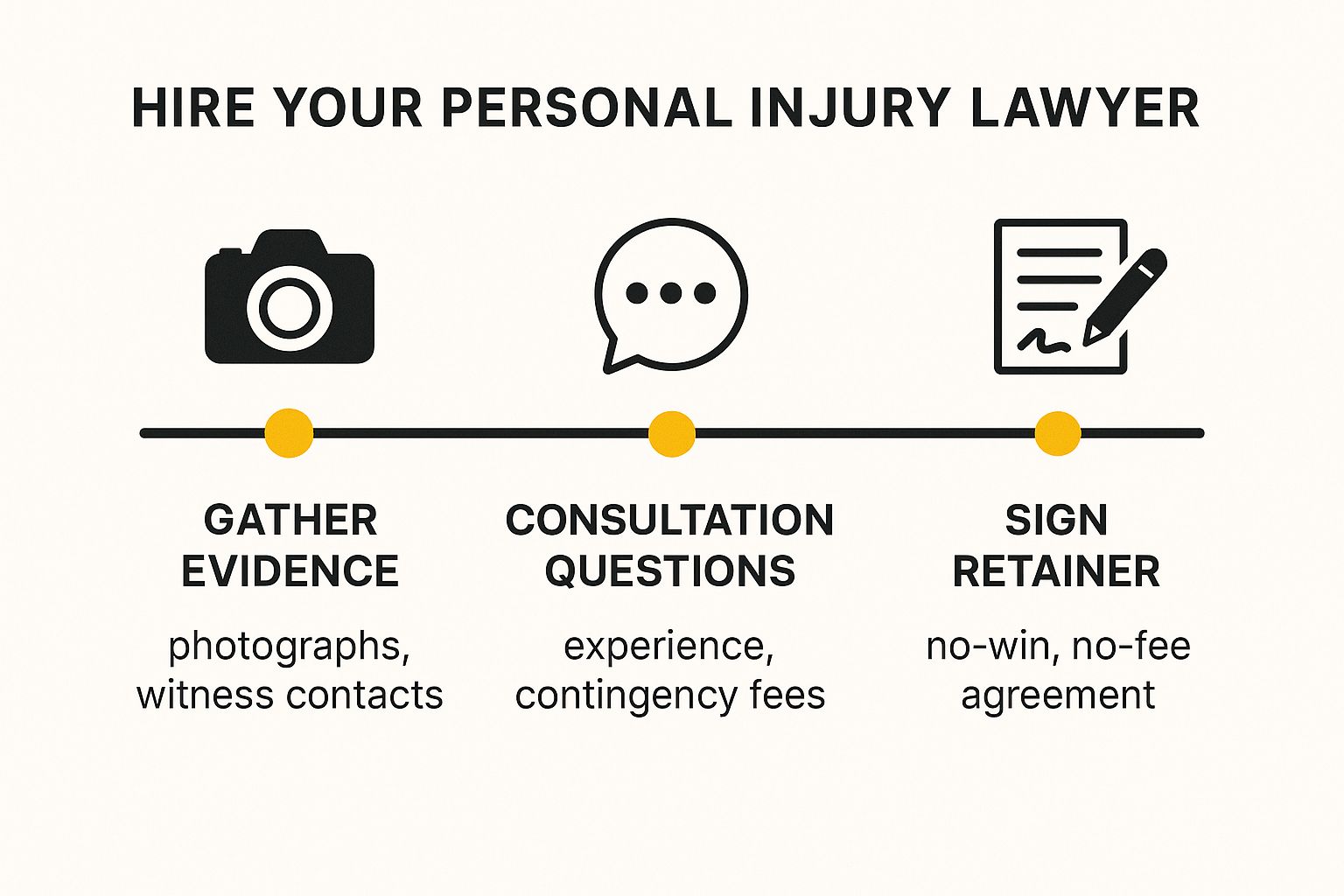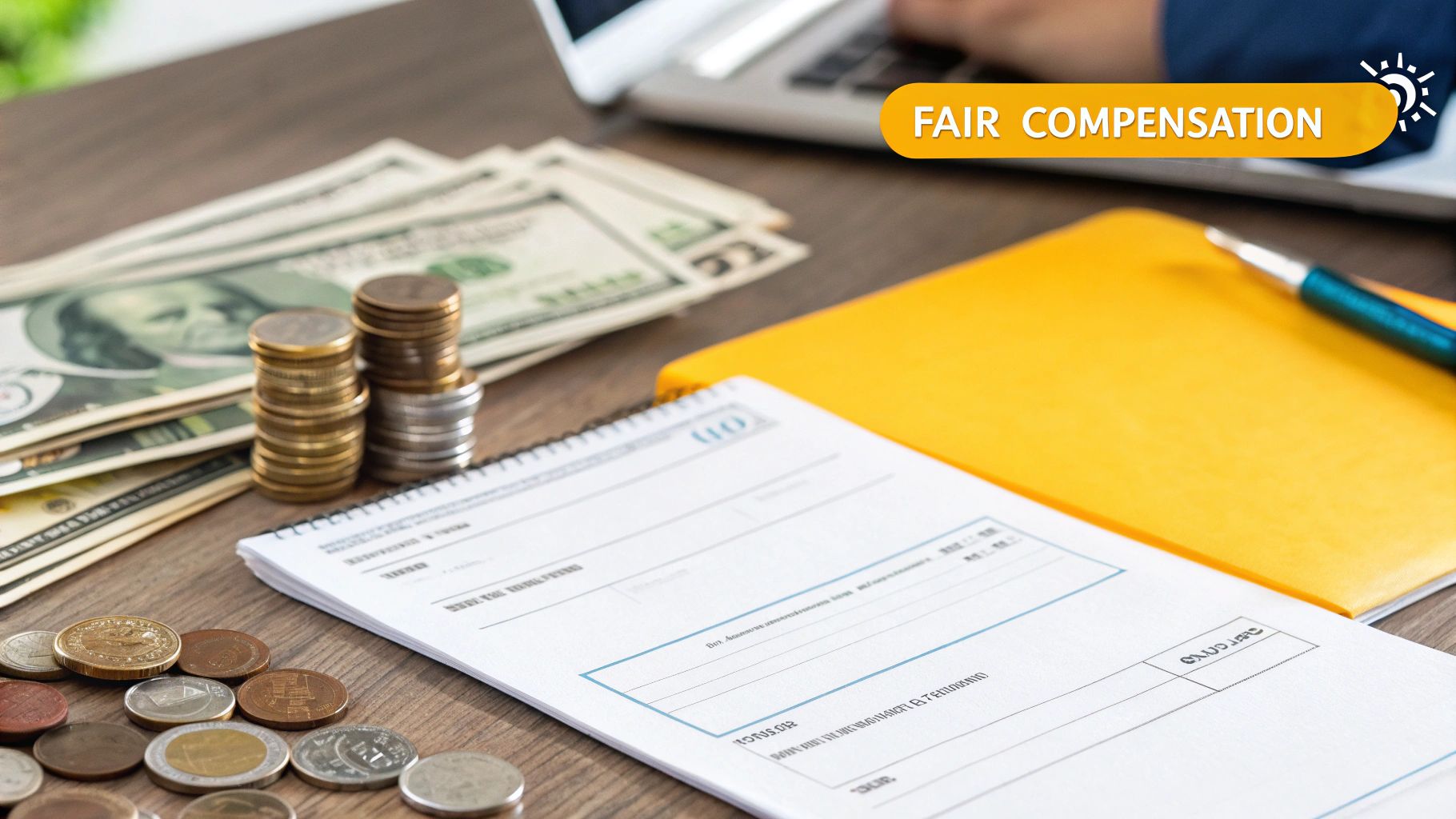Find Your Ontario Slip and Fall Personal Injury Lawyer
A slip on an icy patch outside a shop can turn your world upside down in a second. But here’s something most people don’t realize: not every fall automatically means you have a legal case. For a claim to be valid, you have to prove the property owner was negligent. In simple terms, this means they knew about a hazard and failed to take reasonable steps to keep you safe.
Building that kind of case is tough, and it’s where a seasoned slip and fall personal injury lawyer becomes your most important ally.
Understanding if You Have a Valid Claim

Right after a fall, your head is spinning, and it’s hard to think straight. The most important question isn’t just “Did I fall?” It’s “Why did I fall?” In Ontario, the answer to that question is almost always found in the Occupiers’ Liability Act. This law puts a legal responsibility—a duty of care—on property owners to keep their premises reasonably safe for anyone who comes on their property.
This duty of care is the bedrock of every slip and fall claim. If you just trip over your own feet, that’s usually just an unfortunate accident. But if your fall was caused by an unsafe condition that the owner knew about (or should have known about) and did nothing to fix, you may very well have a strong case.
Distinguishing Accidents from Negligence
Let’s get practical. Imagine you’re in a Burlington grocery store and you slip on a floor that was just mopped. If there was no “wet floor” sign anywhere in sight, that’s a classic example of potential negligence. The store created a hazard but didn’t warn you about it.
Here’s another real-world scenario: you’re walking down the hallway of a Toronto office building and you trip on a piece of carpet that’s frayed and curling up at the edge. If you can show that carpet has been like that for months, it points to a clear failure to maintain a safe environment. The whole case hinges on proving the property owner dropped the ball on their responsibilities.
Key Indicators of a Property Owner’s Liability
As you think back on what happened, look for specific signs that suggest the owner breached their duty of care. These are the details a personal injury lawyer will look for to figure out how strong your case is.
- A Known or Foreseeable Hazard: Was the danger obvious or something that happened regularly? Think of a walkway at a Mississauga mall that always gets icy in the same spot but was never salted.
- Lack of Warnings: Were there any signs, cones, or tape to block off the area or alert you to the danger?
- Poor Maintenance: Was your injury caused by something broken or neglected, like busted stairs, poor lighting in a parking garage, or clutter blocking an aisle?
- Failure to Follow Safety Procedures: Did the staff ignore their own cleaning and inspection schedules?
If you can point to a specific, preventable hazard that caused you to fall, you’ve moved out of the realm of a simple mishap and into a potential personal injury claim. This is precisely when you should pick up the phone and talk to a lawyer.
Getting a handle on these elements is the first step toward protecting your rights. For a better idea of what a successful claim might look like, it helps to learn about how slip and fall compensation is calculated here in Ontario. The more you understand, the more confidently you can move forward.
Finding a Lawyer Who Wins Ontario Injury Cases

After a fall, the single most important decision you’ll make is choosing who represents you. This isn’t just about finding any lawyer; it’s about finding a specialist who lives and breathes Ontario’s unique personal injury laws and has a proven track record of success.
A generalist might handle a dozen different types of law, but a dedicated slip and fall personal injury lawyer has spent years focusing on one thing: holding negligent property owners accountable.
This specialization is critical because these cases are rarely simple. In Ontario, slip and fall claims are governed by the Occupiers’ Liability Act, which demands that property owners keep their premises reasonably safe for visitors. Proving they failed in that duty means showing the owner knew—or should have known—about a hazard and didn’t take reasonable steps to fix it. If you want to dive into the specifics, you can review the full text of the Ontario Occupiers’ Liability Act.
What Sets an Expert Apart
An expert slip and fall lawyer has a deep, practical understanding of this Act and knows how it plays out in courtrooms across the GTA, from Burlington to Toronto. They have a history of successfully negotiating with Canadian insurance giants, who are notorious for trying to minimize payouts. They see the tactics coming and know how to counter them with strong evidence and unwavering advocacy.
Think of it this way: you wouldn’t see a general practitioner for heart surgery. The same logic applies here. You need someone who can spot the nuances of your case from day one and anticipate the legal hurdles ahead.
A true specialist has the resources and the resolve to see your case through. They won’t be intimidated by large corporations or their insurance companies and will be prepared to take your case to trial if a fair settlement isn’t offered.
Your initial consultation is more than just a chat; it’s your chance to vet your potential advocate. Don’t be shy about asking tough questions.
- Trial Experience: “How many slip and fall cases have you actually taken to trial in the past five years?” Many cases settle, but a lawyer’s willingness to go to court is a powerful negotiating tool.
- Case Funding: “Does your firm have the financial resources to fund my case—including expert reports and court fees—if it becomes a lengthy fight?”
- Contingency Fees: “Can you walk me through your contingency fee agreement? What percentage do you charge, and are there any upfront costs I need to be aware of?”
A lawyer’s past performance speaks volumes. It’s always a good idea to explore a firm’s case results to see how they’ve helped people in situations just like yours.
Evaluating a Slip and Fall Lawyer: What to Look For
Sorting through your options can feel overwhelming. To help you make a confident choice, this table breaks down the key qualities of an effective personal injury lawyer versus the warning signs of someone who might not be the right fit.
| Positive Trait | What It Means for Your Case | Red Flag to Avoid |
|---|---|---|
| Specializes in Personal Injury | They have dedicated expertise and up-to-date knowledge of slip and fall law. | A lawyer who “dabbles” in many areas of law and lacks focused experience. |
| Proven Trial Record | Insurance companies know they aren’t afraid to go to court, which often leads to better settlement offers. | A lawyer who has never or rarely taken a case to trial, preferring quick, low settlements. |
| Transparent Fee Structure | You understand exactly how and when they get paid, with no hidden costs or surprises. | Vague answers about fees or pressure to sign a retainer without a clear explanation. |
| Sufficient Firm Resources | The firm can cover all upfront costs for expert witnesses, medical reports, and other critical expenses. | A small, under-resourced firm that may cut corners to save money on your case. |
Ultimately, you’re looking for a partner—someone with the right experience, resources, and commitment to fight for the compensation you deserve.
How to Hire Your Personal Injury Lawyer
Choosing the right lawyer after a slip and fall can feel like a mountain to climb, especially when you’re trying to heal. But it doesn’t have to be overwhelming. The trick is to break it down into a few straightforward steps, so you can move forward with confidence and find the right person to fight for you.
Your preparation starts long before you pick up the phone. The best thing you can do is gather every shred of evidence you can think of related to your fall. I’m talking about photos or videos of the scene (make sure you capture the specific hazard), contact info for anyone who saw what happened, and even your own detailed notes about the conditions at that moment.
This initial legwork is absolutely crucial. It gives a potential lawyer a clear, instant snapshot of your situation and the raw materials they need to start building a strong case.
This infographic breaks down the journey from collecting your evidence to officially bringing your lawyer on board.

Think of it as a roadmap. Hiring a lawyer isn’t some confusing mystery; it’s a structured process you can navigate one step at a time.
Your Free Consultation Checklist
The initial consultation is, for all intents and purposes, a job interview—and you’re the one doing the hiring. You need to go in prepared with sharp questions that get to the heart of their experience, their strategy, and how they operate. It’s also a good idea to get a feel for the people you might be working with. You can often learn a lot by checking out the legal team on their website before you even meet.
Here’s a quick checklist to guide that first conversation:
- Experience: “How many slip and fall cases, specifically like mine, have you handled right here in the GTA?”
- Strategy: “From what you’ve heard so far, what’s your honest, initial take on my claim?”
- Communication: “If I work with you, who will I be dealing with day-to-day? How often will I hear from you?”
- Fees: “Let’s talk about the numbers. Could you walk me through your contingency fee percentage and any other costs that might pop up?”
Never be afraid to ask for more detail. A lawyer who is confident in their abilities will be happy to answer your questions and make sure you understand everything clearly.
Understanding the Retainer Agreement
Once you’ve found the right fit, the last piece of the puzzle is signing the retainer agreement. This is the formal contract that officially kicks off your lawyer-client relationship. In Ontario, the vast majority of personal injury lawyers work on a contingency fee basis. You’ve probably heard it called a “no-win, no-fee” deal.
What this means is simple: you don’t pay any legal fees upfront. Your lawyer only gets paid if they win you a settlement or a court award. Their fee is a set percentage of the money they recover for you.
For instance, a firm in Burlington might operate on a 30% contingency fee. If they secure a $100,000 settlement for your case, their fee would be $30,000. The agreement should also spell out how other costs, like court filing fees or payments for expert witnesses, are managed. Read this document from top to bottom, and don’t sign until every single one of your questions has been answered.
What to Expect from Your Ontario Slip and Fall Lawsuit
So, you’ve hired a slip and fall lawyer. That first big hurdle is over, but now the real legal journey begins. It’s a process that can feel overwhelming, but knowing what’s coming down the road can make a world of difference. From our Burlington office, we’ve guided countless clients through this, and the one thing I always tell them is to think of it as a marathon, not a sprint.
The first thing your lawyer will do is put the at-fault party and their insurance company on formal notice that you’re making a claim. This simple act kicks off a long and detailed period of evidence gathering. We’re talking medical records, expert reports, witness statements—everything needed to build the strongest possible case for you.
This whole initial phase is about laying a solid foundation for everything that comes next.
Key Milestones in the Legal Process
Once the claim is filed, your lawsuit moves into a phase called discovery. This is where both sides lay their cards on the table, formally exchanging all the information and documents they have. A major part of this is the Examination for Discovery, where you’ll be asked questions under oath by the opposing lawyer about the fall and your injuries. It sounds intense, but your lawyer will be right there with you, preparing you for every question.
After discovery, almost every personal injury case in Ontario heads to mandatory mediation. Think of it as a structured negotiation. You, your lawyer, the other side, and a neutral mediator all sit down to see if a fair settlement can be reached. It’s confidential and designed to resolve the case without the stress and cost of a trial.
A surprising number of cases get settled right here. But if the other side isn’t willing to make a fair offer, your lawyer won’t hesitate to prepare for trial. Getting familiar with the stages of personal injury lawsuits can really help you feel more in control during this time.
Navigating Strict Ontario Timelines
Here’s where having an experienced lawyer becomes absolutely critical: the deadlines. Ontario’s legal system runs on a very strict clock. For most slip and fall incidents, the Limitations Act, 2002 gives you two years from the date you fell to file a lawsuit. If you miss that window, your right to sue is gone. For good.
The rules get even tighter if you fall on municipal property. Let’s say you slip on an icy city sidewalk in Toronto or trip in a public park in Hamilton. You are required to give the municipality written notice of your claim within just 10 days of your injury.
This 10-day notice period is a notorious trap. So many valid claims are lost simply because people didn’t know about this incredibly short deadline. This is exactly why it’s so vital to call a personal injury lawyer right away—to protect your rights before it’s too late. You can read the fine print in the Ontario Limitations Act, 2002 for all the details.
Securing the Compensation You Deserve

When you’ve been seriously hurt in a fall, “fair compensation” means so much more than just getting your immediate medical bills paid. A seasoned personal injury lawyer knows the true toll of an injury goes far beyond the initial hospital visit. It can affect your job, your family, and your ability to enjoy life. Their job is to make sure any settlement reflects the total impact on you.
In Ontario, the law divides compensation (or “damages”) into two main types. Each one tackles a different part of the harm you’ve suffered, and understanding both is key to seeing what your claim is really worth.
Pecuniary Damages: The Tangible Costs
Let’s start with the straightforward stuff. Pecuniary damages are all the losses that can be calculated down to the dollar. Think of these as the concrete financial setbacks you’ve faced because of your injury.
This covers a lot more than you might think:
- Lost Income: All the wages you’ve already missed out on because you couldn’t work.
- Future Loss of Earnings: This is often the biggest piece of the puzzle. It’s compensation for the income you won’t be able to earn in the future if your injury affects your career long-term.
- Medical and Rehabilitation Costs: Anything OHIP doesn’t cover falls here—physiotherapy, prescriptions, wheelchairs, or even modifications needed for your home or car.
- Housekeeping and Home Maintenance: If you can no longer handle things like cleaning or yard work, the cost of hiring someone to help can be included.
Take, for example, a Hamilton construction worker who can’t go back to their physically demanding job after a bad fall on a neglected property. Their claim for future lost earnings alone could be worth hundreds of thousands of dollars, completely dwarfing the initial medical expenses.
Non-Pecuniary Damages: The Human Cost
The second category is for the losses that don’t come with a neat price tag. Non-pecuniary damages are meant to compensate for the very real, but intangible, human side of your injury.
This is compensation for your pain and suffering, loss of enjoyment of life, and the emotional toll of the accident. It’s about acknowledging how your quality of life has changed—maybe you can no longer play with your kids, pursue a favourite hobby, or simply live without daily pain.
Putting a number on this is far from simple. The amount is influenced by the severity of your injuries, how they impact your life and work, and the degree of the property owner’s negligence.
Ontario’s laws also have some tricky rules, like a deductible that applies to pain and suffering awards below a certain threshold. This is exactly where an expert makes a difference—they know how to properly value this part of your claim and navigate the system to get what you are rightfully owed. You can dig deeper into the specifics of pain and suffering damages to see how it all works. For more on how these amounts are adjusted annually, you can check the Financial Services Regulatory Authority of Ontario’s guidelines.
Common Questions About Ontario Slip and Fall Claims
After a serious fall, your head is likely swimming with questions. It’s a confusing and stressful time, and the thought of dealing with legal matters can feel overwhelming. We get it. To help clear things up, we’ve put together answers to the questions we hear most often from people just like you across the GTA and Ontario.
How Much Does It Cost to Hire a Slip and Fall Lawyer?
This is usually the first question on everyone’s mind, and for good reason. The good news is that you don’t need a lot of money to get expert legal help.
Almost every personal injury lawyer in Ontario works on what’s called a contingency fee basis. You might have heard it called a “no-win, no-fee” arrangement. What this means for you is simple: you pay zero legal fees upfront. Your lawyer only gets paid if they win your case, and their fee is a pre-determined percentage of the final settlement or court award.
This approach levels the playing field, ensuring anyone can afford top-tier legal representation, regardless of their financial situation. Everything is spelled out in the retainer agreement before you commit to anything.
What If the Fall Was Partially My Fault?
This is a very common situation, so don’t assume you don’t have a case. Ontario law recognizes that accidents aren’t always black and white.
Under the Negligence Act, a concept called contributory negligence comes into play. It means that fault can be shared. Maybe you were glancing at your phone when you tripped on a cracked sidewalk. While your brief distraction might have played a part, the property owner still had a duty to fix that hazardous crack.
In cases like these, a court will determine the percentage of fault for each person involved. Your total compensation would then be reduced by your percentage. A sharp lawyer’s job is to build a strong case showing the property owner holds the vast majority of the blame, which minimizes your portion of fault and protects your settlement.
How Long Does a Slip and Fall Case Take in Ontario?
Honestly, there’s no simple, one-size-fits-all answer here. The timeline for a slip and fall claim really depends on the specifics of what happened.
- Straightforward Cases: If the property owner’s fault is obvious and your injuries are clearly documented, your case might settle in about a year to eighteen months.
- Complex Cases: Things can take longer if the property owner is denying responsibility, or if your injuries are severe and the long-term medical outlook is uncertain. These claims can often last from two to four years, particularly if they’re heading toward a trial.
A good lawyer will always push for the most efficient path forward, but never at the expense of your well-being. The real goal is securing the full and fair compensation you’re entitled to, and sometimes that just takes time.
Navigating the aftermath of a slip and fall requires expert guidance. At UL Lawyers, our team is dedicated to helping you understand your rights and securing the compensation you deserve. We serve clients across the GTA and all of Ontario. Contact us today for a free, no-obligation consultation to discuss your case by visiting UL Lawyers.
Related Resources
Finding a Car Accident Lawyer Hamilton Trusts
Continue reading Finding a Car Accident Lawyer Hamilton TrustsYour Guide to Finding a Slip and Fall Lawyer in Brampton
Continue reading Your Guide to Finding a Slip and Fall Lawyer in BramptonNEED A LAWYER?
We are here 24/7 to address your case. You can speak with a lawyer to request a consultation.
905-744-8888GET STARTED WITH A FREE CONSULTATION
Why Choose UL Lawyers
- Decades of combined experience
- Millions recovered for our clients
- No fee unless we win your case
- 24/7 client support
- Personalized legal strategies